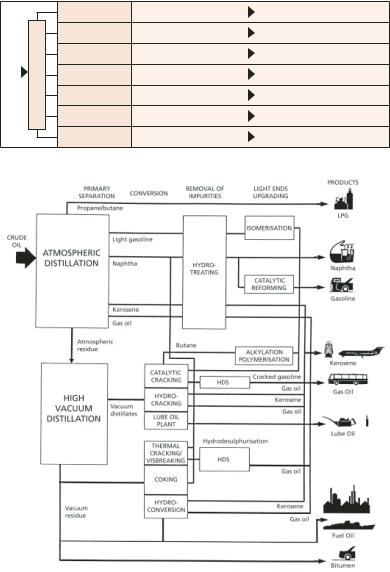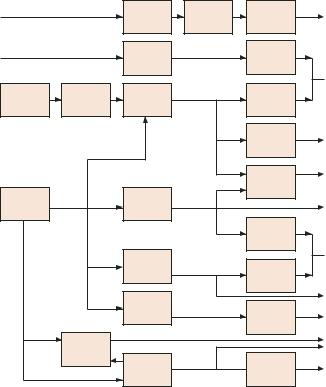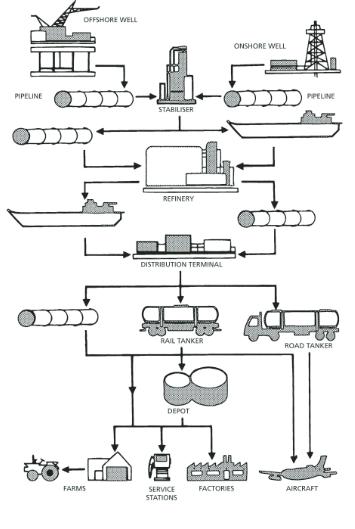
SpeakingOilGas
.pdfThe lightest fractions — gases like butane and propane — have simple molecular structures and are boiled off first. They rise to the top of the column where they are removed. The rising vapours of other fractions cool sufficiently to condense back into liquid form and they are taken off at progressively lower condensation points in the tower. Fuel oils and bitumen at the heavy end are taken from near the tower base.
This distillation process separates the crude into eight basic components which are then subjected to a secondary refining process known as cracking. This usually combines more intense heat in the presence of a zeolite catalyst — hence the term catalytic cracking or cat cracking. The treatment rearranges the particular fraction’s molecules which are then sorted and blended, sometimes with the addition of other chemicals, to make final products like kerosene, petrol, diesel, lube oils and asphalts.
The products are distributed by pipeline, road and sea to distribution terminals, then to smaller depots and finally to the end consumers.
Natural gas
Pipeline gas
Natural gas flows from the wellhead to production facilities that initially separate out oil, condensate and water. This is followed by a process to remove remaining water and any sulphur compounds and ‘scrubbing’ to remove inert gases like nitrogen and carbon dioxide as well as natural gas liquids such as butane and propane. Sometimes ethane is also removed. The remaining methane sales gas is piped to market or it is liquefied to be transported as LNG.
Liquefied Natural Gas (LNG)
LNG is produced by refrigerating the methane to a temperature of -161 degrees Celsius. The supercooled gas condenses to form a liquid which occupies one six-hundredth of the space of its gaseous form. It is an elaborate process, but the only economic and proven method of reducing natural gas volumes sufficiently for bulk transport by ship (or occasionally by road tanker).
156 |
SPEAKING OIL & GAS |
The first stage of the process is the same as for production of domestic sales gas, i.e. removal of all impurities, inert gases, water and heavier hydrocarbons (oil, condensate, butane and propane). If left in the gas stream they would freeze and disrupt the cooling process.
The liquefaction plant can be likened to a giant household refrigerator where the four main elements in the cooling cycle — a compressor, a condenser, a pressure-expansion valve and an evaporator — are built on a huge scale. A single liquefaction unit (called a train) can contain hundreds of kilometres of special cold-resistant nickel steel and aluminium alloy piping. Ordinary steel is unsuitable because it becomes brittle at low temperatures.
The cooling cycle begins with the compression of a low pressure gas (a refrigerant). Compression raises its temperature and pressure. The warm high pressure gas is then passed through a condenser where it gives up its heat to a coolant (which may be water or the directed flow of ordinary air). The refrigerant’s temperature falls and it liquefies. Using the principle that the lower the pressure, the lower the boiling point, the refrigerant is then passed through an expansion valve to lower its pressure.
With the low temperature thus produced, the refrigerant can then be used to take heat from the raw natural gas stream. This is done in an evaporator where a heat exchange lowers the temperature of the natural gas and increases that of the refrigerant to the point where the latter regasifies.
The refrigerant gas is returned to the compressor to begin its cycle again, while the continuous heat exchange in the evaporator cools the natural gas stream to its liquefaction point.
To keep the LNG in a liquid state, special steels and insulating materials are used in the tanks in which it is stored, as well as in the loading lines to seagoing LNG carriers and in the carriers onboard cargo tanks. Despite this, a proportion of the LNG inevitably evaporates. This so-called boil-off gas is compressed and recycled back to the LNG plant’s fuel system. In the LNG carrier the boil-off gas is used to fire the vessel’s boilers.
DOWNSTREAM PROCESSES |
157 |

|
<90° |
Butane and Lighter |
Gas processing |
|
|
90°–220° |
Straight Run Gasoline |
Motor Gasoline Blending |
|
Oil |
220°–315° |
Naphtha |
Cat Reforming |
|
|
|
|
||
Crude |
315°–450° |
Kerosene |
Hydrotreating |
|
450°–650° |
Light Gas Oil |
Distillate Fuel Blending |
||
|
||||
|
650°–800° |
Heavy Gas Oil |
Cat Cracking |
|
|
800°+ |
Straight Run Residue |
Flashing |
Distilling crude and product disposition
Elements of a typical refinery
158 |
SPEAKING OIL & GAS |

C4H10 Butane
|
Liquefied |
|
|
Petroleum Gas |
|
C3H8 Propane |
||
|
||
|
Natural Gas Liquids |
|
C2H8 Ethane |
||
|
||
|
|
|
CH4 Methane |
Liquefied Natural Gas |
|
N2 Nitrogen |
|
|
|
|
|
CO2 Carbon Dioxide |
Natural Gas |
|
H2O Water |
|
|
Constituents of the respective gases |
|
There has been some work done on the design of floating offshore LNG plants as well as locating LNG plants on artificial islands, but as yet there has not been any commercial application.
Methanol
Another process of growing importance and using natural gas as a feedstock is the production of methanol. Methanol in turn can be used as a feedstock for chemical manufacture, such as acetic acid and formaldehyde, and is being considered as a fuel for power generation as well as in fuel cell technology. In addition it can be used as a petrol extender, i.e. blending small amounts with petrol for use in an internal combustion engine. Methanol is also a mid-stage in the process for making petrol from natural gas.
The conversion of natural gas to methanol involves removing impurities followed by production of synthesis gas (a mixture of carbon dioxide, carbon monoxide, hydrogen and oxygen) using hot water and steam. This synthesis gas is then passed over a catalyst which promotes the rearrangement of chemical elements to produce methanol.
DOWNSTREAM PROCESSES |
159 |

The further step of converting methanol to petrol involves the use of another catalyst which again promotes rearrangement of the chemical elements. There is also successful research into the conversion of natural gas directly to petrol without the intermediate methanol stage.
Methanol plants are relatively common around the world. One of the best known is in New Zealand which uses gas fed in from fields in the Taranaki Basin off the west coast of the North Island. At one time it also took the second stage to produce petrol, but this is now a minor side in the plant’s operations.
|
|
Hydrogen |
Ammonia |
Ammonium |
Fertilisers |
|
|
Sulphate |
|||
|
|
|
|
|
|
|
|
Methanol |
|
Urea |
|
|
|
|
formaldehyde |
|
|
|
|
|
|
|
|
|
|
|
|
|
Plastics & |
|
|
|
|
|
Adhesives |
Natural Gas |
Ethene |
Ethylene |
|
Polyethylene |
|
|
|
|
|
Ethanol |
Chemicals |
|
|
|
|
|
Plastics & |
|
|
|
|
Styrene |
Adhesives |
|
|
|
|
|
|
Naphtha |
|
Benzene |
|
|
Insecticides |
|
|
|
|
|
|
|
|
|
|
Cyclohexane |
|
|
|
|
|
|
Synthetic |
|
|
Xylene |
|
|
Fibres |
|
|
|
|
|
|
|
|
|
|
Polyesters |
|
|
|
|
|
|
Paints, Varnishes |
|
|
Toluene |
|
|
Plastics |
|
|
|
|
Phenols |
|
|
|
|
|
|
Synthetic Rubber |
|
Butadiene |
|
|
|
Chemicals |
|
|
Propylene |
|
Acetone |
Plastics, |
|
|
|
Synthetic Fibres |
||
|
|
|
|
|
Petrochemicals from petroleum — simplified diagram
160 |
SPEAKING OIL & GAS |
There has also been research into ‘miniaturising’ a methanol plant for use in remote natural gas fields offshore, either as a floating facility or built on a manmade concrete island. The former concept prompted construction of a small research facility built by BHP Billiton near Melbourne in Victoria, Australia which takes gas from Bass Strait as its feedstock. Plans to construct a floating facility have not yet come to fruition.
The island concept however, is under design feasibility stage for the proposed Tassie Shoals 1.7 million tonnes per year methanol project planned for shallow water in the Timor Sea off northern Australia, which will take gas from the nearby Evans Shoal field.
Petrochemicals
Some of the products from the oil refinery cat cracker and the gas fractionation plants are further treated by refrigeration, compression and chemical reaction in a separate plant to produce a range of petrochemicals. The most familiar of these are polymers or plastics such as polyethylene, polypropylene, nylon and perspex. Petrochemical products also include synthetic rubber, pesticides, fertilisers and a host of solvents which are used as additives in petrol, anti-freeze, pharmaceuticals, foods, cosmetics, paint and detergents.
Although economic alternatives may be found for some petroleum fuels during the next three or four decades, the wide range of applications and growing array of end products from the petrochemical industry has established petroleum as a cornerstone of modern living. Its significance is unlikely to diminish in the foreseeable future.
DOWNSTREAM PROCESSES |
161 |

The oil transportation network
162 |
SPEAKING OIL & GAS |
Appendix 1.
PETROLEUM SPECIALISTS
Assayer– an analyst who performs physical and chemical tests on petroleum samples to determine the type and amount of each component.
Derrickman – a member of the drilling crew who works on the monkey board up in the rig derrick above the floor and guides the top end of each stand of drill pipe as it is pulled out or run into the hole.
Diver/Sub-mariner – carries out underwater mechanical tasks down to depths of 200 metres during drilling and production via diving bells. For deeper waters a remotely operated vehicle (ROV) is used and controlled electronically by an operator from the surface.
Driller – the senior member of the drilling rig crew who manages the drilling operation and keeps a log or drilling report which is a narrative account of events on the rig floor during his/her tour of duty.
Drilling Superintendent – head of a company’s drilling department who is in overall charge of drilling operations, often with responsibility for work being done by several rigs at one time. Duties include planning, supervision and liaison with other company departments.
Electrical/Electronic Engineer – is responsible for electrical and electronic systems used in production and treatment facilities and in refineries.
Environmental Engineer – responsible for design aspects that minimise environmental impact of the equipment and various processes used in production and treatment of petroleum and petroleum products.
Geochemist – studies the chemical composition of the earth’s crust and analyses sediments above likely petroleum-bearing formations that could help determine the presence of petroleum traps.
APPENDIX 1. PETROLEUM SPECIALISTS |
163 |
Geologist – studies the origin, history and construction of the earth’s crust and uses knowledge of rock types, fossils and structural movements to help pinpoint places where petroleum traps may be found. Some geologists look at the global ‘big picture’ to determine which countries and regions of the world are the most prospective for petroleum discoveries.
Geophysicist – studies the structure of the earth by physical measurement and uses a range of techniques such as seismic pulses, magnetics and gravitational forces to define potential petroleum traps. There are geophysicists who look at whole basins and entire regions to determine major structural features and trends within the global context.
Jughound (Juggie) – a member of the survey crew who places geophones and cables in position (onshore).
Landman (USA only) – an agent who works on behalf of an oil company to acquire land for oil field operations through lease arrangements, direct purchases and access/usage agreements with land owners.
Marketer/Trader – responsible for sale and/or purchase of petroleum and petroleum products using knowledge of global supply and demand, petroleum prices and hedging techniques.
Motorman – a member of the drilling rig crew who maintains the prime mover motors that keep the drill turning.
Mud Engineer – plans the type and weight of drilling mud that best suits the formations being drilled.
Petrochemical Engineer – a chemical engineer responsible for the design, management and control of the process which transform crude oil into energy products, such as petrol, diesel and gas, and other products such as plastics, fibres and paint. Processes can include gas-to-methanol and gas-to-oil techniques.
164 |
SPEAKING OIL & GAS |
Petrophysicist – responsible for determining the potential quality and performance of a petroleum resource by estimating how much hydrocarbon is present and whether it can be produced economically. The primary task is to estimate porosity and water saturation by analysing core samples, well logs, pressure measurements, well tests and other geological information gained from downhole operations.
Pipeline Engineer – responsible for design and construction of petroleum pipelines.
Process/Chemical Engineer – designs and oversees the facilities for treatment and quality control of petroleum during the separation and manufacture of its various components, particularly in the refining and petrochemical stages.
Production Engineer – designs and oversees the production facilities used to extract petroleum from the underground reservoir and treat or separate the fluid components.
Reservoir Engineer – studies the type of petroleum trap discovered, including areal extent, rock properties, fluid pressures and structural elements to determine the volume of reserves and the optimum placement of development wells to efficiently recover the maximum volume of oil or gas.
Roughneck – a rig labourer who assists in facets of the drilling operation, such as handling casing, drill pipe, tongs and other tools used on the rig floor.
Roustabout – a general purpose labourer who works on a drilling site handling bulk supplies and assisting in tasks not directly connected with drilling.
Seismic Operator – a member of the seismic crew who records all the data from the seismic pulses using specialised computer equipment.
APPENDIX 1. PETROLEUM SPECIALISTS |
165 |
